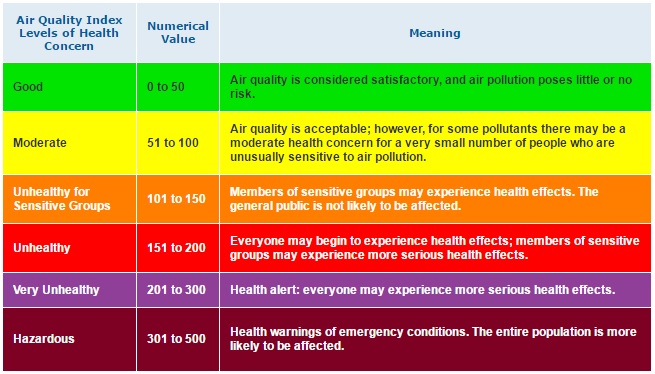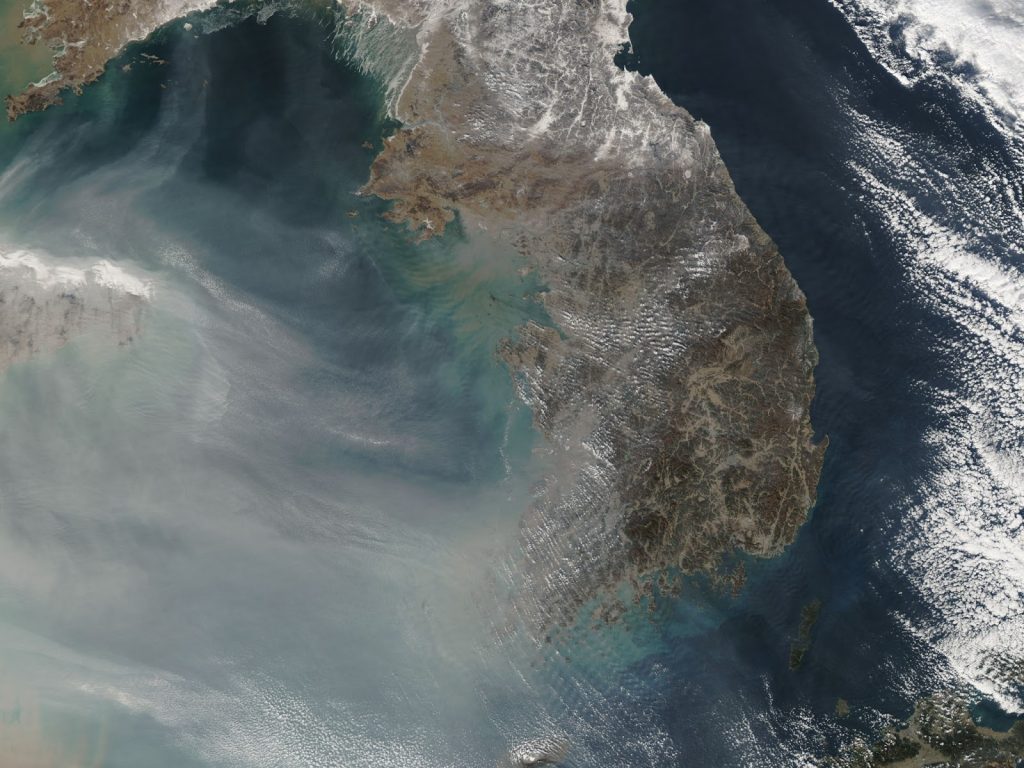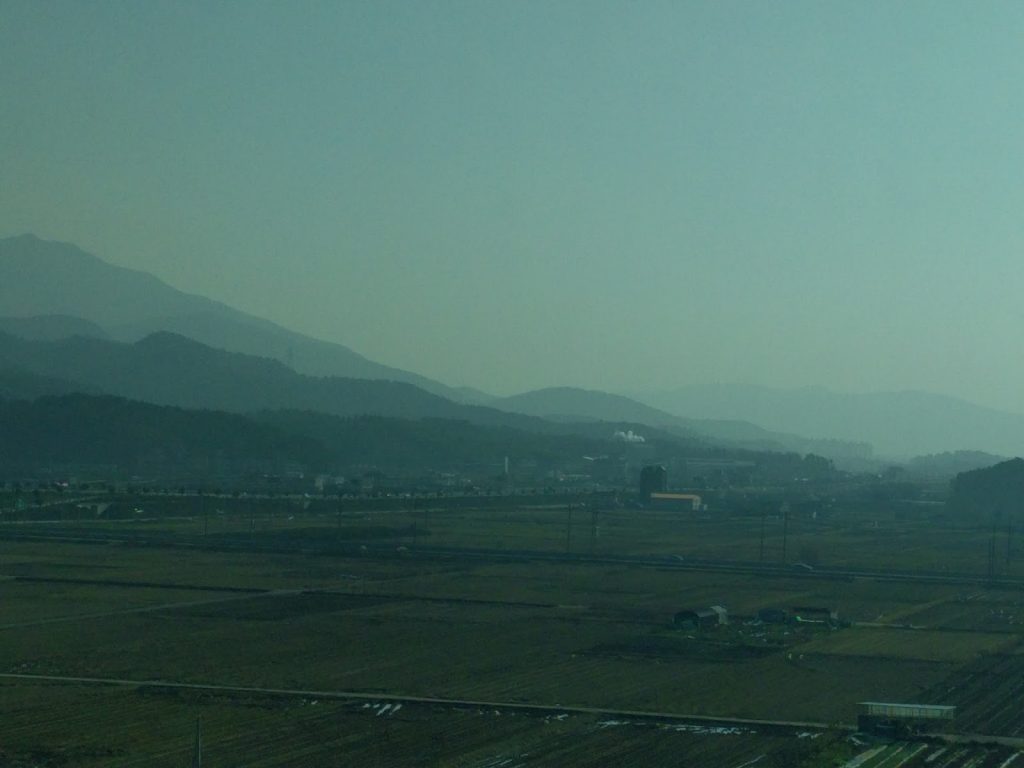We’ve only been in Korea for a couple months, but I have to say that we are enjoying it. Our district is beautiful, the food is yummy (well, most of it), people are nice, and it’s safe and clean. I would like to be better with language (more on that later), but nearly all the Koreans we encounter are kind and patient with our painful mangling of their native tongue. While there are some inconveniences, so far we have only noticed one big downside to living in Korea.
Smog.
Specifically: Chinese smog.
That’s right, all that nasty off-the-charts hazardous smog you’ve been hearing about in China lately (if you follow international news) blows across the Yellow Sea and right over the Korean peninsula.
I have this app on my phone that shows me air quality readings nearby. It even has a little map that lets you see air quality readings throughout Korea. If I check it frequently enough, I can tell when smog is coming, because I’ll notice some reds pop up on the west coast. Then, they start moving east, towards our district, then on to Busan, and often all the way to Kumamoto in southern Japan.

What are “reds”? It’s an Unhealthy air quality reading. Here’s the air quality index…

On a normal day, most of Korea should be greens and yellows. Maybe orange. To be fair, Korea creates many of its own smog problems, but primarily in the big cities. Seoul can get pretty nasty all by itself. But we live in a small town on the coast. Even with diesel vehicles and farmers burning rubbish piles, we should not have a major problem with particulates.
Here’s a map of Korea on what I would call a “mixed” day. Seoul is that big cluster on the upper left, and Busan is the bottom right.

See those reds popping up on the west coast? Where could they be coming from?

Want an actual picture? Here’s a satellite photo of China. All those brown clouds you see are smog.

And here’s that smog blowing towards Korea.

It’s pretty ugly from ground level, too. These photos were taken from my living room…



What is causing all this hellish smog in China? Well, it’s a somewhat complex answer involving economic development, mountain ranges, humidity levels, atmospheric layers, rising global temperatures altering air flow in the northern hemisphere, and various poorly understood interactions between sulfates, nitrogen oxides, water vapor, and particulates.
But the short answer is: coal, coal, and more coal.
Coal is a dirty, dirty source of energy, but we’ve been using it for thousands of years (intensely since the Industrial Revolution) and just can’t seem to kick the habit. In fact, coal consumption worldwide increased over 70% from 2000 to 2013, and is projected to increase more with development in India and Southeast Asia. Today, China accounts for half of global coal consumption.
In the face of public outrage over shrinking life expectancy and the millions (yes, millions) of premature deaths each year due to air pollution, the Chinese government announced plans in 2013 to tackle the country’s pollution problems. They gave their environmental regulations some enforcement power, closed many of the worst-polluting factories, set limits on car sales, and banned coal burning in urban areas. China now leads the world in renewable energy investment. These measures, along with a general economic slowdown, are helping to a certain degree. Each of the past few years has seen a decrease in the highest concentrations of PM2.5 (small particulates… the ones that can get into your bloodstream and wreak havoc with your cardiovascular system), as well as a decrease in the number of red, purple, and brown days.
But they have a long way to go. Just this past month, Northeast China experienced its longest stretch of severe smog days, and during that time some cities in the area recorded air quality readings approaching 1000. (Note that the chart above stops at 500.)
Lest you mock the Chinese government for its short-sightedness, let me remind you that it was not that long ago Los Angeles had the worst air quality in the world. The city began having smog problems in the early 1900s, but it was during the WWII economic boom things really got bad. A severe bout of smog in 1943 – in which visibility was reduced to 3 blocks and residents thought it was an enemy “gas attack” – finally brought air pollution to the public’s attention. The smog problem persisted for decades, until the Clean Air Act and emissions regulations eventually brought it under control. Now, while the air in downtown LA is not going to be the same as Middle-of-Nowheresville, Montana, it’s a vast improvement.
And for the life of me, I cannot understand the current administration’s desire to roll back emissions standards. If you think it’s so great giving business precedence over the environment, come take a look out my window and see what that philosophy has done to this part of the world.
And lest you think it could never again get that bad in America, consider this… After London’s Great Smog of 1952 killed 12,000 people, Britain enacted its own set of air quality and emissions controls to bring smog under control. But just last week, thanks to traffic pollution and a massive increase in the number of households using cheap wood burning stoves, London’s government issued their highest air pollution alert for the first time, calling it a “health crisis.” Air quality readings in London exceeded those in Beijing.
So… yeah. Until somebody invents Mr. Fusion,* we need to protect our existing regulations, support energy innovations, and make smart, energy-saving choices in the home.
Oh, and keep a mask handy. Just in case.

*High five if you get the reference.

